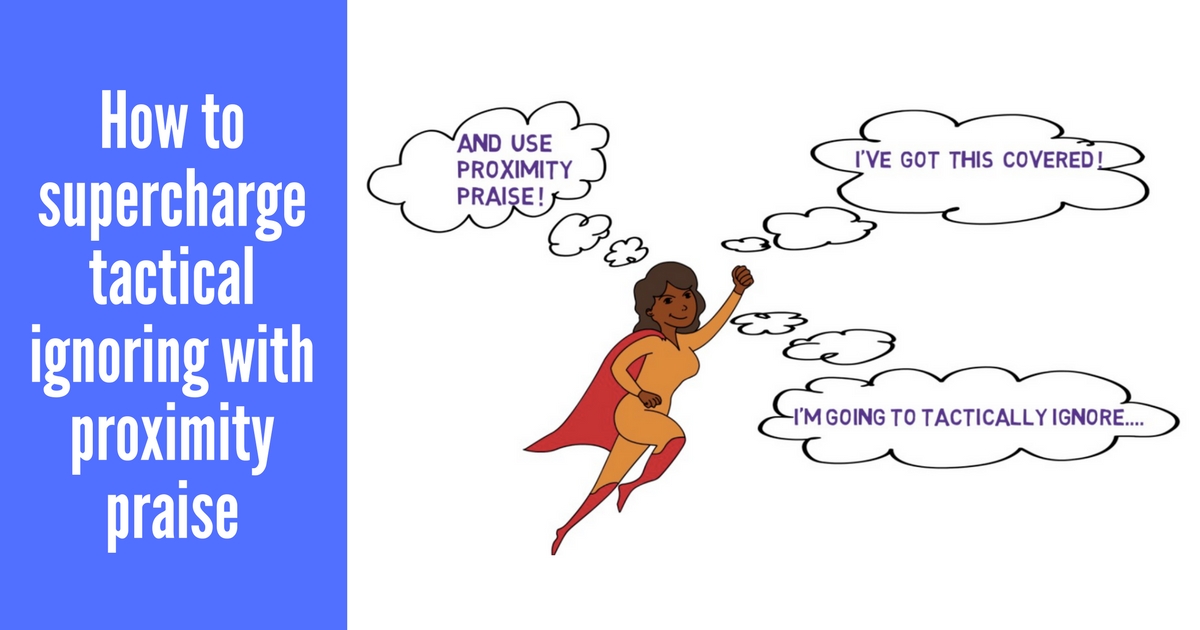The most effective way to change unwanted behaviours is to play down the attention we (the adult) give to them.
Unfortunately, on its own, this strategy won’t be enough.
We’re going to need to supercharge this approach of ‘tactical ignoring’, by coupling it to another technique, one which actively draws attention towards the positive behaviours we do want to see in class.
Unfortunately, we sometimes sabotage our behaviour management by instinctively doing the opposite. When we see a pupil acting in a way we don’t like, we often look, frown or talk about their behaviour. This is a natural, human response, but it’s not a useful one in this scenario.
In fact, when we do the above, we actually encourage the pupil to magnify the unwanted behaviour.
It goes like this:
- Jack has stopped work and is tapping his pencil loudly on the table, whilst looking at you.
- You notice the tapping and turn to look at who is doing it.
- Jack realises he has gained your attention, continues to look at you (maybe jutting his chin out a little too!) and he taps more loudly on the table.
- His classmates feel the tension between you and down tools, waiting in anticipation, ready to see what happens next…
Stop right there!
Smart teachers recognise that this exchange can go one of two ways – what the adult does next could either escalate or de-escalate this situation.
So we now have two options:
Option 1 – publicly confront Jack over the pencil tapping
Option 2 – decide to focus attention on the behaviour you WOULD like to see.
Let’s explore both of these.
Option 1
You call across the classroom to tell Jack to stop making that noise and get on with his work. Now, for some pupils, that might work. Jack will stop, put his head down and get on with his work, and his classmates will quickly do the same.
However, this is a risky plan.
If Jack can’t actually do the work (or he thinks he can’t), his pencil tapping may have been a way of signalling to you that he is stuck or feeling anxious. It’s not an appropriate method of asking for help, but it’s worked in the past as a way of attracting adults’ attention.
So now, Jack feels humiliated that his classmates are looking at him, and he doesn’t know how to do the work.
He feels like he is being attacked. His likely response in this situation is some kind of counter attack. That may be to up his agitated behaviour by tapping more loudly and challenging you with eye contact to see what you will do next, or it could take the form of verbally back chatting e.g. ‘It wasn’t me.’ ‘Why do you always blame?’ ‘You’re not helping me, I’m not doing it.’
This kind of standoff is difficult to come down from. It’s likely now that nobody in class is actually doing any work – they’re all watching to see what happens next.
Both you and Jack feel emotionally triggered and someone has to back down. To lose face. And everyone is looking. And you have to get on with the next lesson.
And now Connor has started tapping his pencil too…
AAAAAAAARRRGGGHHH! This is stressful!
So, let’s rewind and think about how this confrontation could have been avoided altogether.
Option 2
You decide to focus your attention on the behaviours that you would like to see.
The moment that you notice Jack tapping his pencil, you take a breath. You’re in charge of your response.
You chose to play down the unwanted behaviour (this is called tactical ignoring) and intentionally focus your time, energy and attention on the children who are getting on with their work nearby. This is called proximity praise.
This is when you draw attention to individuals or groups of children engaging in positive behaviour. For example, ‘Thank you everyone on this table who has already written the date,’ or ‘Adam, I love the way you are working in silence, this lets other people concentrate. Well done.’
You could even follow up with a whole class reminder. ‘Remember class, if you are stuck, put up your hand and I will come and help you in a moment.’
The effect of this approach is two fold.
- you keep the rest of the class on side and give them reassurance that you are in control of the situation.
- you’re reminding Jack subtly what he needs to do to get your attention.
This also gives time for Jack to get back on task (without any negative attention) and for you to think about how you will address his behaviour if he continues tapping the pencil.
What’s your next move? If the tapping stops, then I would wait until the end of the lesson, when everyone has left the room, and have a quiet word with Jack to remind him that you are happy to help him and how he needs to attract your attention in the correct way.
If the tapping continues, I would go over to Jack and have a similar, quiet conversation, perhaps starting him off with the first part of the work so that he overcomes some of the anxiety. Making your intervention less public, and less confrontational, means you’re far more likely to get the result you want.
Then continue to look for and praise the behaviour that you want to see – in Jack and everyone else!
To find out more about skilfully managing your pupil’s difficult behaviour, sign up for our Guide to Managing Attention Seeking Behaviour

